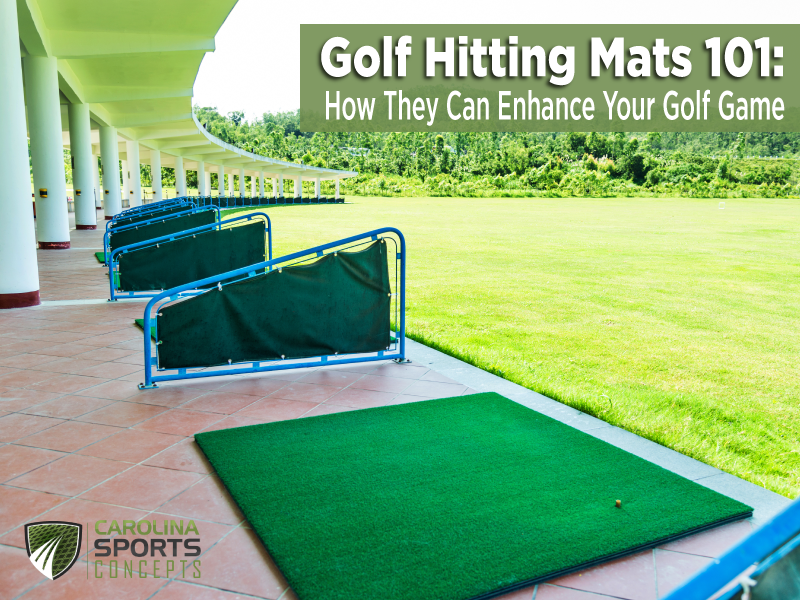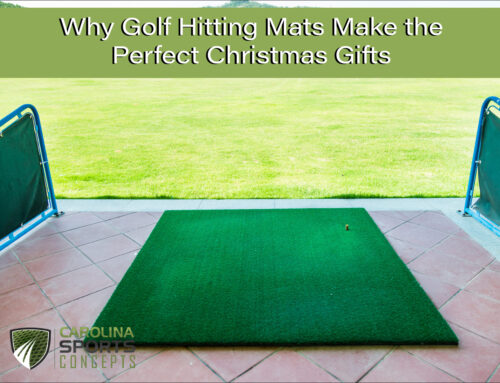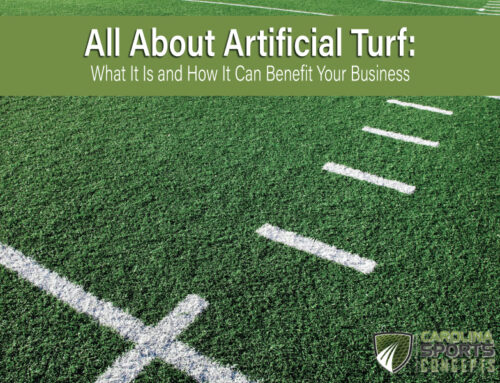When it comes to your golf swing, consistency is the key. Not only do you need to be consistent in your form, but you also need to work hard at maintaining your swing day by day. That’s where golf hitting mats come in.
Your best chance of improving and upkeeping your swing lies in practice. And whether you hit balls at the driving range, in your backyard, or your garage, using a golf mat can help you achieve your ultimate goal—developing a swing that your golfing buddies envy! Plus, you don’t have to worry about destroying your lawn in the process.
Of course, not all golf mats are created equally, which is why we sell Tee Line Turf mats that are maintenance-free and attractive. If you’re ready to take your game to the next level, investing in a golf mat is worthwhile. Below, we explain the role of golf mats in more detail.
How Golf Mats Can Impact Your Game
Every golfer is different, which means that using golf mats can yield different results for each golfer. However, there are a couple of factors that ring true no matter if you’re a novice or professional:
More Practice
The obvious question when determining whether or not to invest in a golf mat is, “Will it really benefit my game?” The short answer is yes. The very fact that you will be able to practice more means that you’ll be getting the repetition necessary to improve your swing. And you really will have easier access to practice because you can work on your swing almost anywhere you are when you have a golf mat.
Say, for example, you’re running behind schedule at work and you don’t have time to hit up your local driving range. If you have a mat at home, you can get in a few shots after work. Consequently, this can help you stay consistent; practicing even a little bit each day will do wonders for improving your overall golf game.
Nonetheless, there’s no way for artificial turf to provide the same experience as natural grass. Golf mats make it relatively easy to get a clean hit on the ball because there is no grass, dirt, or water to interfere. In other words, you’re going to have a perfect lie every time you swing on a mat.
Additionally, your golf mat might move around a little bit after frequent use, which also makes it a different experience than playing on natural grass. Despite these differences, your swing can benefit significantly from practicing on a mat. It’s just important to practice on natural grass occasionally if you notice yourself having problems on the course that you don’t have at home.
Injury
A lot of golfers who play on golf mats complain about having pain in their arms and wrists. Sometimes, injuries can occur from simply overdoing it or employing bad form. But oftentimes, golf-related injuries result from improperly using a golf mat.
Take, for instance, if you accidentally hit the ground during your swing. If it happens while playing on natural grass, you will meet less resistance than when hitting on a mat. Particularly older models of golf mats can feel like you’re hitting concrete, which is obviously going to jar your joints more so than natural grass.
Fortunately, golf mats have come a long way in recent years, with newer products like Tee Line Turf mats providing a much more forgiving result. When selecting a golf mat, consider how well the material absorbs contact so that you can help prevent injury during your practice sessions.
The Benefits of Using Golf Mats
Practicing on golf hitting mats provides you with great consistency. Not only are you able to practice at home and anywhere else you have a mat, but you get the same lie every time you hit a ball. As a result, you can sharpen your skills with minimal variation—a pull is a pull, and you can’t blame it on anything but yourself!
If you like to incorporate swing drills into your practice routine, you can do so with mats without having to move locations after each shot. Say, for instance, that you want to practice your ball positioning. You can just place an alignment stick or golf club perpendicular to your target line and get into position. If you were practicing on natural grass, you would have to move the ball and reset your alignment device after each shot. Along with adding convenience to your practice session, it also allows you to fit more swings into your dedicated practice time.
Factors to Keep in Mind
There are some downsides to using golf hitting mats for practice. But being aware of them will help you to minimize the negative aspects and maximize the benefits. In other words, these are not reasons to avoid the use of golf mats but rather concepts that can help ensure you get the most of your time on the mat.
Feedback
Since golf hitting mats don’t provide the give of natural grass, there is a greater risk of injury. But this also means there is less feedback when practicing on a mat. The extra bounce you get from a golf mat’s harder surface can be a problem if you don’t remain mindful of it. For example, if you’re practicing your iron and hit your low point before contacting the ball, your club is going to bounce off the surface of the mat, leaving your contact to feel clean. And if you’re hitting into a net, you might not notice the consequences of a bad hit.
Take that same scenario and replace the golf mat with natural grass. You would see and feel the result of hitting your low point before making contact with the ball. It would impact where the ball went, not to mention fling dirt and grass into the air.
False Confidence
Practicing on a golf mat is different than playing on the course, and it’s critical to keep that in mind every time you practice. Just because you have a personal best at the driving range doesn’t mean your next game of 18 won’t be your worst ever. On the other side of the coin, there may be times when you have a horrible practice on your golf mat only to exceed your highest expectations during your next game.
You may even find that you consistently perform poorly on your golf mat and much better when you play rounds on the course. The key is to remember that you cannot fully trust how well you hit a golf ball off of a mat as a predictor of how you will play on a course. It is simply an excellent resource for warming up and developing your swing.
Club Variations
Lastly, some clubs are more ideal for practicing on a mat than others. Irons are perhaps the best clubs for practicing on golf mats for a number of reasons that we will get into later. And golf mats can be a great resource for practicing your driver as long as you use your tees the right way. For right now, just note that golf mats tend to make fairway woods, hybrids, and wedges bounce dramatically, which can prove problematic when you’re trying to perfect your swing.
How to Use Golf Mats Effectively
As we’ve discussed, there are both benefits and challenges to practicing on a golf mat. Being aware of the challenges will help you understand how to adapt your practice sessions, avoid an inaccurate perception of your progress, and target the skills you most need to sharpen. It’s generally easier to hit shorter clubs on a golf mat than longer clubs, and golf clubs with wider soles tend to be more difficult because they have more bounce. Nonetheless, learning how to utilize each of your clubs will help you have a productive practice no matter what you’re hitting.
Hitting Your Driver
Golf mats are terrific for sharpening your driving skills. In particular, using a mat is valuable for helping you perfect your stance. When driving, you ultimately want to hit the ball on an upward trajectory, which is why you use a tee. But with a golf mat, you don’t have the same interference that comes with natural grass, and it’s relatively easy to hit up on the ball and achieve clean contact. That said, this will only work if you are consistent with how you use your tees.
Some golf mats will not accommodate tees. Even if you can use tees on your artificial turf, opt for shorter ones. You’re not going to be able to push the tee deep into the ground like you would with natural grass, and using a regular-length tee is going to put your ball much too high off the ground. The key is to make sure the height of your tee on the golf mat is true to what you will be playing with when you tee up at the course.
Hitting Your Irons
Hitting irons is perhaps the most enjoyable part of practicing on a golf mat. They don’t bounce as much as a wedge but aren’t as long as a driver. Mastering your irons should be a top priority since they take up such a large portion of your game. There are a couple of drills worth considering that could help you sharpen your iron skills by way of a golf mat:
Drill Number 1 — Simply put a towel on the ground about four or five inches behind the ball and then practice your swing. If the towel goes untouched, it’s a clean hit. If the towel moves, it shows that you’re bottoming out before making contact with the ball. Because feedback is not ideal when hitting an iron from a golf mat, this drill can help you get an accurate picture of whether or not you are hitting the ball cleanly.
Drill Number 2 — Put three golf balls in a row in front of your club, while imagining a fourth ball at the front. Take your stance in front of the imaginary ball and take a practice swing. Then, step forward, swing, and hit the next ball, and repeat this process until you’ve hit all three balls. Rather than settling in before you hit each ball, you’ll want to accomplish a steady rhythm of swinging and stepping, as the repetitive motion will sharpen your tempo and balance. This is an excellent drill for developing your rhythm and tempo.
Features to Look For
Just as there are many different applications of artificial turf, there are various types of golf mats on the market. Understanding what distinguishes them will help you determine which product you should invest in for improving your golf game. There are three main factors to consider: feel, stability, and durability.
Realistic Feel
It’s safe to say that you want your golf hitting mat to feel as close to natural grass as possible. Certain mats can make poor shots look attractive because the club bounces through the air instead of digging into the ground. This can prove detrimental to your practice goals because it can give you the misconception that you’re hitting much better than you would on the course. It’s critical to choose a golf mat that mimics the realistic grass/ground interaction while also providing a consistent feel.
Stability
The ultimate goal of stability in your golf mat is that it stays in place when contact is made and that your feet are kept stationary. This means that you need a mat that provides both foot stability and stability in the mat itself.
Certain mats can cause your mat to shift up to two inches during a normal swing. That is some significant movement which you should try to avoid. Be sure that the golf mat you choose has the correct thickness and softness.
You also don’t want the golf mat itself to move around when you swing. It’s best to dedicate a spot where you can dig your mat into the ground or attach it to the floor; otherwise, the speed of your swing can dictate the movement of your mat. And if you use a two-piece golf mat, both the piece you stand on and the one you hit off of can move, which can lead to double trouble!
Durability
Having a durable golf mat is essential because it will determine how much money and energy is wasted in the long run. In the simplest terms, your golf mat should remain in good condition for tens of thousands of shots. If you invest in a low-quality mat with no durability, you will quickly notice the mat developing a dip where you hit your balls. Over time, that dip will make it harder and harder to hit balls off of your mat.
Conclusion
You’re not going to get the swing of your dreams without putting in the time. By using golf hitting mats, you can practice anywhere and not worry about destroying your yard. Keep the tips above in mind as you choose a golf mat and develop your practice routine. And remember to come to Carolina Sports Concepts for all of your artificial turf needs!






